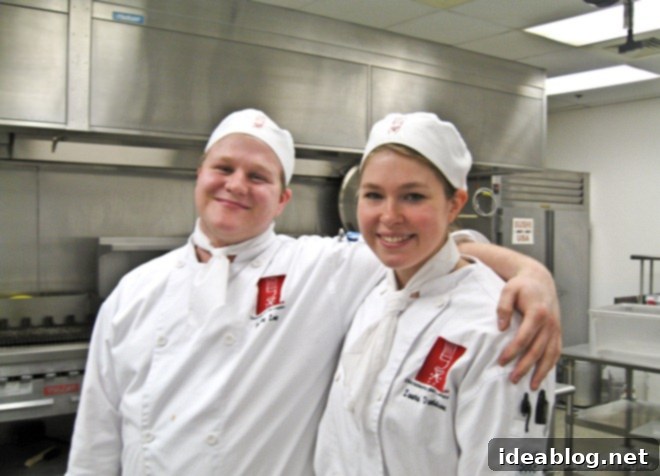A Culinary School Day: Mastering Carrot Cake, Braised Mahi Mahi, and Decadent Escargot
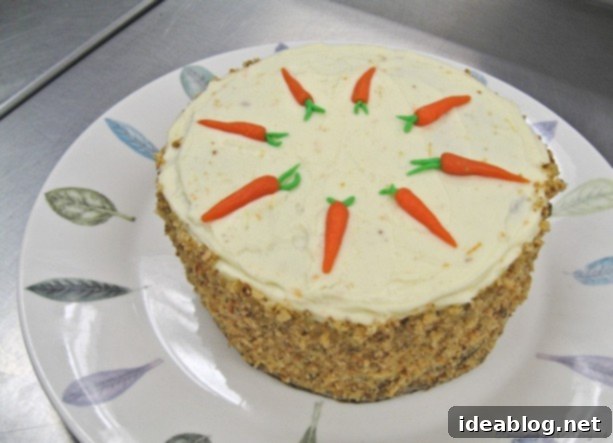
What a truly exceptional day it was in our bustling culinary school kitchen! Thursday unfolded as a wonderfully productive and remarkably relaxed session, a pleasant deviation from our usual intense schedule. Unexpectedly, we found ourselves completing our production tasks significantly ahead of time, leaving us with a rare moment to breathe and even “kill some time” before the lunch service. This unhurried pace allowed for an added layer of focus and enjoyment in crafting each dish, a stark contrast to the typical race against the clock. It truly was an odd but welcome feeling, enabling us to perfect every detail of our diverse and delicious menu.
Adding to the day’s allure was an incredibly appealing menu that certainly surpassed the challenges of a chicken mousse day. Among the stars of our culinary creations was one of my all-time favorite desserts: the classic carrot cake. The meticulous process began on Wednesday afternoon when we prepared the cake bases, ensuring they had ample time to cool and set. This strategic planning meant that Thursday’s class could be entirely dedicated to the artistry of decoration and assembly. Our recipe for this delightful treat incorporated part whole wheat flour, offering a nuanced texture and a touch of wholesome goodness. We enriched the batter with crushed pineapple, freshly grated carrots, crunchy walnuts, and plump raisins, all contributing to an incredibly moist and flavorful cake that was a joy to behold and taste.
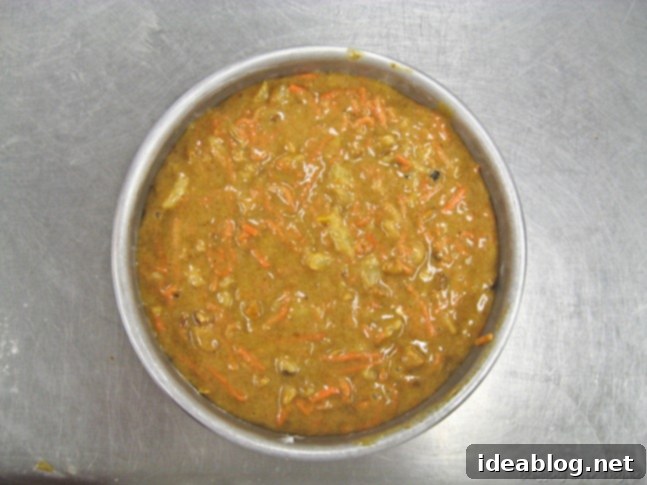
On Thursday, our primary focus shifted to crafting the perfect accompaniment for our carrot cakes: a luscious cream cheese frosting. This was no ordinary frosting; it was meticulously flavored to achieve a harmonious balance. We infused it with the bright, citrusy notes of Grand Marnier, fresh orange and lemon zest, and a hint of vanilla, creating a sophisticated flavor profile. Crucially, we used only a small amount of powdered sugar, ensuring the frosting was not overly sweet but rather subtly decadent, allowing the natural flavors of the cake to shine through. With our expertly prepared cakes sliced into two even layers, the exciting process of frosting and decorating commenced. Each student took great care to apply the creamy frosting smoothly, preparing the canvas for the final decorative touches.
Once our cakes were beautifully frosted, we meticulously decorated the sides, gently pressing finely chopped walnuts into the soft cream cheese. This not only added a delightful textural contrast but also a refined visual appeal. Then came the truly enjoyable part: fashioning intricate marzipan carrots for a charming, decorative flourish atop each cake. Because we weren’t pressed for time with the rest of our menu, we had the luxury of taking our time with these delicate creations. Rolling and shaping the marzipan, adding subtle indentations, and coloring them just right was a wonderful exercise in precision and creativity. This unhurried pace was a welcome change, allowing us to fully immerse ourselves in the artistic details of dessert preparation, resulting in truly stunning and personalized carrot cakes.
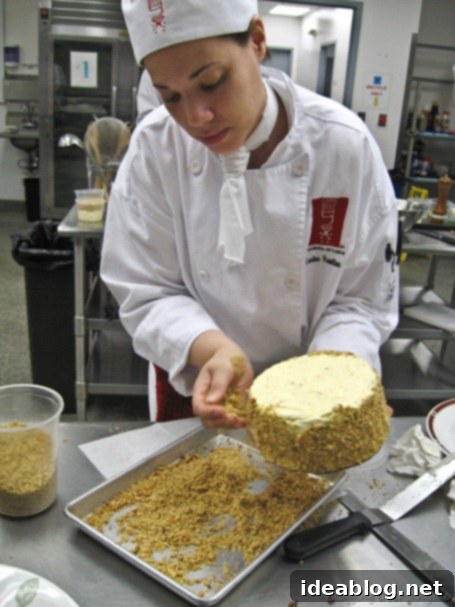
Transitioning from the sweet to the savory, our main course for the day was an exquisitely prepared braised Mahi Mahi filet. This was a delightful departure from the traditional bluefish often used for this recipe, a necessary adjustment due to sourcing difficulties. Mahi Mahi, with its firm yet delicate flesh, proved to be an excellent substitute, offering a beautiful texture and mild flavor profile that paired perfectly with our chosen sauce. The fish was served alongside a classic Bercy sauce, a quick yet sophisticated creation that elevates any seafood dish. This elegant sauce is built upon a reduction of white wine, a rich fish fumet (stock), and finely diced shallots, finished with a generous whisking of cold butter and a sprinkle of fresh parsley, creating a vibrant and savory accompaniment.
The preparation of the Mahi Mahi involved a meticulous braising technique designed to preserve its moisture and infuse it with rich flavors. We began by lining a well-greased pan with thinly sliced shallots and a fragrant bouquet garni, a bundle of herbs that imparts aromatic depth. The fish filets were then placed atop this aromatic bed, and the pan was filled approximately one-third of the way with crisp white wine. To ensure a moist cooking environment and even heat distribution, we covered the pan with a cartouche (a parchment paper lid) before placing it in the oven. The fish was cooked until it was just about perfectly done, ensuring it remained tender and flaky. At this precise moment, we carefully removed the fish and proceeded to transform the remaining pan liquids into a superb sauce. By cooking down the wine mixture and incorporating the remaining ingredients, we built a flavorful foundation. The final, crucial step involved whisking in cubes of cold butter, which emulsified beautifully to create a glossy, rich sauce, brightened by a generous amount of finely chopped parsley. This method yielded a main course that was both elegant and incredibly flavorful, showcasing refined cooking techniques.
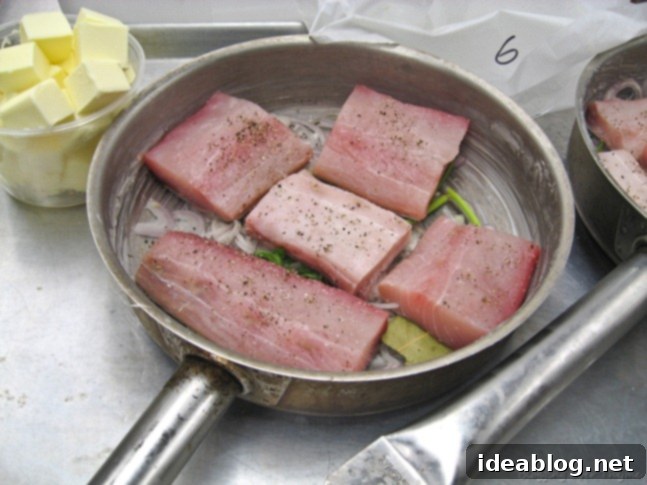
I found myself thoroughly enjoying this fish dish. The Mahi Mahi was incredibly moist and delicate, a testament to the careful braising technique employed. It offered a refreshing and welcome change from our typically red meat-centric menus, providing a lighter yet equally satisfying culinary experience. The subtle flavors of the fish, enhanced by the exquisite Bercy sauce, created a truly memorable main course. It highlighted the versatility of our culinary training and the importance of adapting recipes to available ingredients while maintaining high standards of taste and presentation.
To perfectly complement the delicate braised Mahi Mahi, we served it with a simple yet classic combination: a fluffy rice pilaf and freshly sautéed spinach. The rice pilaf provided a comforting and absorbent base, ideal for soaking up the delicious Bercy sauce. The spinach, quickly cooked just before serving, added a touch of vibrant color and a fresh, earthy counterpoint to the richness of the fish and sauce. This minimalist approach to side dishes allowed the main course to truly shine, emphasizing flavor and texture harmony without unnecessary distractions. It was a well-rounded and expertly executed meal that demonstrated the beauty of balanced flavors and thoughtful pairings in a professional culinary setting.
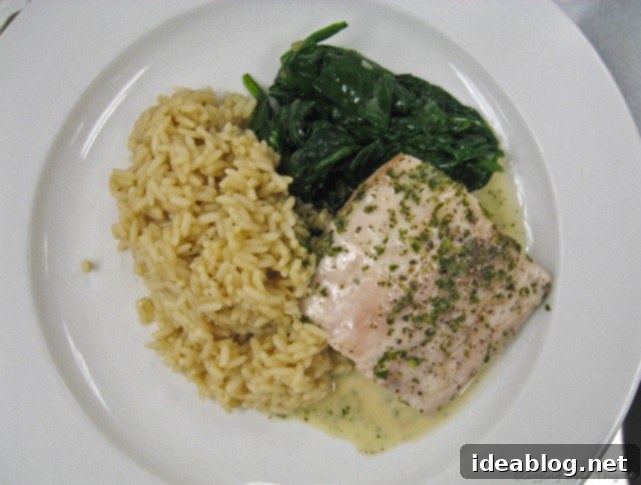
And now, for an appetizer that always sparks conversation: escargot, or snails! My fondness for these intriguing morsels dates back to a childhood trip to France when I was just 10 or 11 years old. From that moment, I’ve absolutely adored them. While the idea of eating snails might sound a bit unconventional or even “gross” to some, trust me when I say that when they are prepared correctly—bathed in generous amounts of rich butter, aromatic parsley, and pungent garlic—they transform into something utterly delicious and undeniably yummy. This dish is a true testament to how simple ingredients can create a gourmet experience, especially when approached with classic French culinary techniques. Our task in the kitchen was to create an escargot dish that captured this classic appeal, presenting it with flair and flavor.
Our escargot were presented in elegant puff pastry cups, a testament to our ongoing pastry training. We created these delicate, flaky vessels by cutting specially prepared puff pastry, which we had meticulously made the day before, using a very precise technique. This method ensures that, once baked, the pastry rises beautifully to form a shallow, edible bowl, perfect for holding a variety of savory or even sweet fillings. This was our inaugural attempt at making these specific puff pastry cups in class, and while they might seem complex, they are apparently set to become a familiar staple in Phase II of our culinary program. Mastering such fundamental pastry skills is crucial for any aspiring chef, and these cups provided an excellent hands-on learning experience in laminating dough and precise shaping, showcasing the versatility of puff pastry beyond traditional desserts.
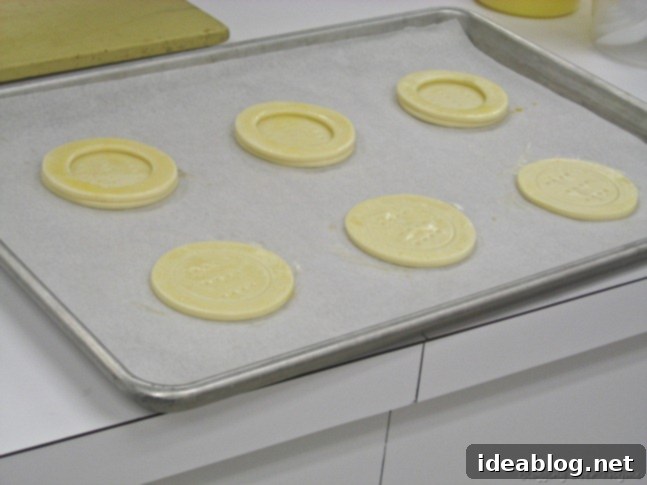
Although our freshly baked puff pastry cups emerged from the oven perhaps more oval than perfectly round, their charm and deliciousness were undeniable. Despite this slight variation in shape, they were nonetheless beautiful and served as an excellent foundation for our escargot appetizer. The slight imperfections are a natural part of the learning process in culinary school, reminding us that every dish is an opportunity for growth and refinement. The most important aspect was their flaky texture and buttery flavor, which perfectly complemented the savory filling we were about to prepare, demonstrating the underlying quality of our pastry work.
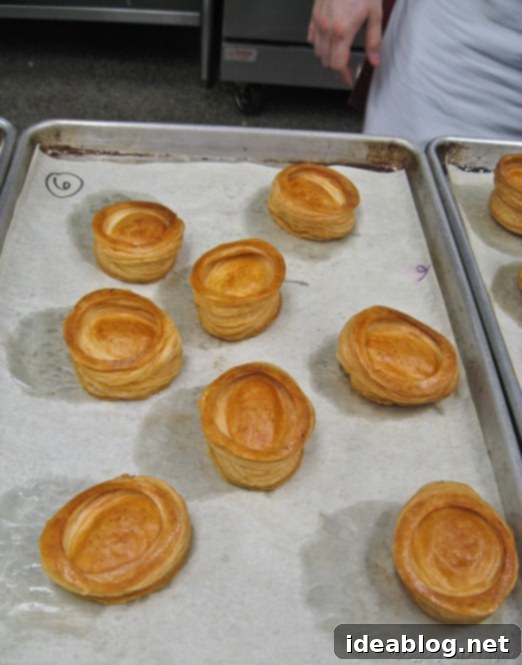
For our snail preparation, we created a simple yet incredibly potent compound butter. This butter, designed to infuse maximum flavor, was generously blended with fresh parsley, pungent garlic, a subtle hint of Cognac, and, of course, a substantial amount of high-quality butter. The key to a great escargot lies in this aromatic butter, which melts and coats each snail, transforming it into a luxurious bite. The balance of herbs, alcohol, and fat is crucial for achieving that authentic, rich flavor that makes escargot so irresistible. We focused on ensuring every ingredient was perfectly incorporated, creating a butter that was truly the heart of the dish.
The preparation of the escargot itself involved several classic culinary techniques. We started with canned snails, which required careful cleaning; we blanched them to ensure freshness and proper texture. At the last minute, to preserve their delicate nature, we sautéed them quickly in clarified butter until tender. Then came the exciting and slightly nerve-wracking part: flambéing them with a small amount of Cognac! This was a first-time experience for many in our class, and thankfully, everyone, including the kitchen, remained intact by the end of this spectacular step. The flambéing not only added a depth of flavor from the caramelized alcohol but also a dramatic flair to the cooking process. Immediately after the flames subsided, we incorporated our rich compound butter, allowing it to melt and envelop the snails, creating that iconic buttery, garlicky aroma and taste.
With the snails perfectly cooked and coated in their flavorful butter, we then meticulously filled the individual puff pastry cups. Each cup received a generous portion of the escargot mixture, ensuring a satisfying bite. To elevate the presentation and add an extra layer of savory depth, we topped each serving with a small spoonful of highly reduced demi-glace. This concentrated veal stock offered a rich, glossy finish and a complex umami flavor that beautifully complemented the garlic and butter. While the presentation was undeniably fun and elegant to assemble, I felt, upon tasting, that our version might have benefited from an even more generous quantity of compound butter. It didn’t quite achieve the exact flavor profile we experienced in the chef’s demo, suggesting a subtle balance that comes with practice and keen observation. Nevertheless, it was a fantastic learning experience in both technique and flavor refinement.
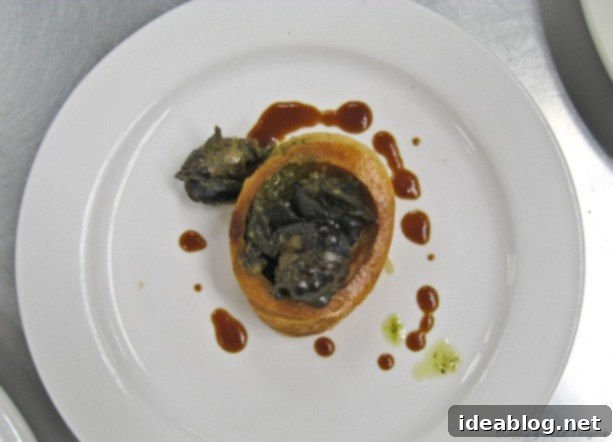
As the intense afternoon production wound down, our culinary school day wasn’t quite over. Following a thorough, deep clean of the kitchen—an essential part of maintaining a professional cooking environment—we had a crucial meeting with Chef Brian to review the results of our most recent practical exam. These feedback sessions are invaluable for understanding our progress and areas for improvement. After that, we dedicated some time to practicing our piping skills, using stiff meringue as our medium, honing the precision and artistic flair required for exquisite dessert decoration. But the true highlight of the late afternoon awaited us: a special invitation to the Phase I classroom for a delightful and highly anticipated Bavarian cream buffet. This event promised to be a feast for both the eyes and the palate, showcasing the incredible talent of our pastry colleagues.
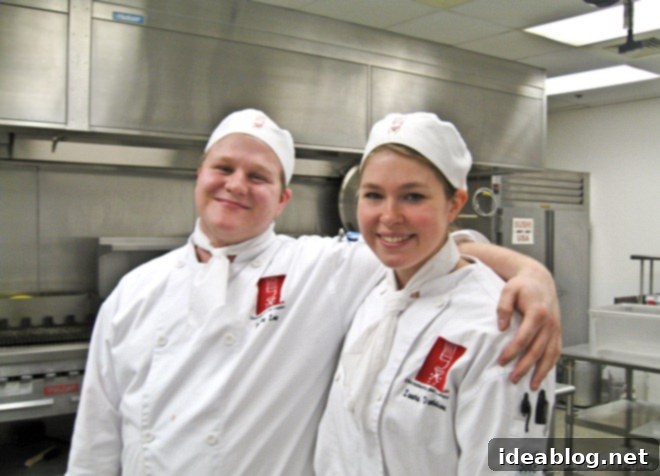
The Bavarian cream buffet was an extraordinary showcase of creativity and skill from our fellow pastry students. Each student had been diligently working for days to conceptualize, prepare, and perfect their own uniquely flavored Bavarian cream dessert. The result was an astonishing array of individual culinary masterpieces, each a testament to their dedication to the art of pastry. We were graciously invited to taste as many as we desired, an incredible opportunity to sample a wide spectrum of innovative flavor combinations. Despite the tempting variety, I managed to limit myself to a small bite of one or two, ensuring I could appreciate the nuanced craftsmanship without overindulging. The sheer visual beauty of the desserts was captivating, and the atmosphere was one of shared appreciation for the intricate work involved in creating such delicate and delicious treats.
The array of Bavarian creams on display was nothing short of stunning. Each dessert was a miniature work of art, meticulously crafted and beautifully presented. The creativity of the pastry students truly shone through in the diverse and imaginative flavor combinations they developed. From the intriguing pairing of blackberry and green tea to the classic yet vibrant blend of chocolate and orange, and the refreshing trio of blueberry, kiwi, and blackberry, there was an incredible variety to explore. These unique flavor profiles demonstrated an adventurous spirit and a deep understanding of ingredient harmony. It was a true celebration of culinary innovation and the boundless possibilities within pastry arts, providing immense inspiration for all of us.
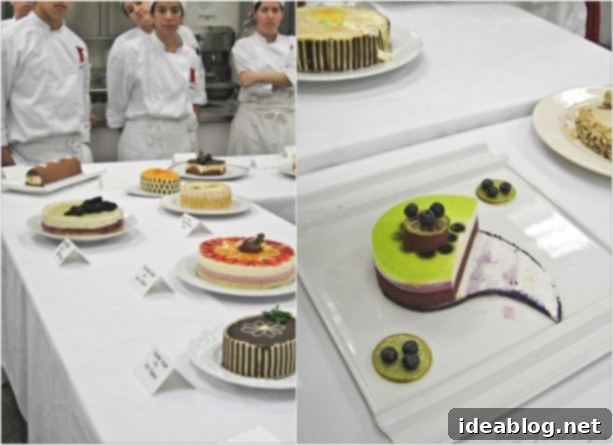
Among the many exquisite offerings, one dessert captivated me completely and stood out as my absolute favorite. Pictured at the bottom, this particular Bavarian cream was a masterful blend of pistachio and chocolate, a pairing that in itself is heavenly. What made it truly exceptional, however, were the subtle, refreshing hints of mint woven throughout. This addition elevated the dessert, providing a bright counterpoint to the richness of the chocolate and the nutty earthiness of the pistachio. It was not only visually beautiful, with its elegant presentation and harmonious colors, but also incredibly delicious. The balance of flavors was perfect—neither overly sweet nor excessively rich, allowing each component to be distinctly appreciated. It was a testament to sophisticated flavor development and expert execution, leaving a lasting impression on my palate.
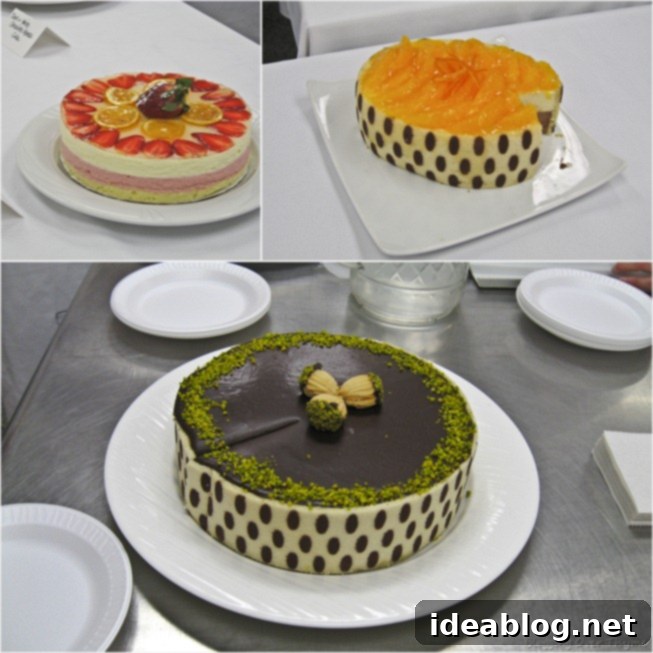
This fantastic Bavarian cream buffet was undoubtedly a fun and memorable way to culminate a busy and educational week in culinary school. As we look ahead, the upcoming week promises to be equally challenging and exciting. We have our third significant paper due, focusing on vegetables, which requires extensive research and culinary insight. Furthermore, critical meetings are scheduled to discuss our externship placements, a significant milestone that will transition us from the classroom to real-world kitchen environments. It’s truly astonishing to realize that this is officially our second to last week in Phase I! Time has flown by incredibly fast, filled with a whirlwind of learning new techniques, mastering complex recipes, and honing essential kitchen skills. The journey has been intense, rewarding, and transformative.
The rapid progression through our culinary program is a testament to the comprehensive and demanding curriculum. It’s hard to believe how much we’ve learned and grown in such a short period, moving from basic knife skills to preparing gourmet dishes like those featured today. The anticipation for what the externship phase will bring is immense, marking a pivotal step in our professional development as chefs. I am eagerly looking forward to sharing many more details about our continued culinary adventures and breakthroughs in the coming weeks. For now, I sincerely hope you all had a great weekend, and I wish everyone successful and flavorful days ahead as we push through the final stages of Phase I and prepare for the next exciting chapter in our culinary education.
